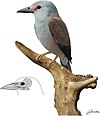Campephilus
Appearance
| Campephilus | |
|---|---|

| |
| Pale-billed woodpecker (Campephilus guatemalensis) | |
| Scientific classification | |
| Domain: | Eukaryota |
| Kingdom: | Animalia |
| Phylum: | Chordata |
| Class: | Aves |
| Order: | Piciformes |
| Family: | Picidae |
| Tribe: | Campephilini |
| Genus: | Campephilus G.R. Gray, 1840 |
| Type species | |
| Picus principalis[1] Linnaeus, 1758
| |
| Species | |
|
see text | |
Campephilus is a genus of large American woodpeckers in the family Picidae.[2]
Taxonomy
[edit]The genus Campephilus was introduced by English zoologist George Robert Gray in 1840, with the ivory-billed woodpecker (Campephilus principalis) as the type species.[3] The genus name combines the Ancient Greek kampē meaning "caterpillar" and philos meaning "loving".[4] The genus is placed in the tribe Campephilini in the subfamily Picinae and is sister to a clade containing woodpeckers from Southeast Asia in the genera Chrysocolaptes, Blythipicus, and Reinwardtipicus.[5]
Species
[edit]The genus contains 12 species:[6]
| Image | Common Name | Scientific name | Distribution |
|---|---|---|---|
 |
Powerful woodpecker | Campephilus pollens | Colombia, Ecuador, Peru, and Venezuela |
 |
Splendid woodpecker | Campephilus splendens | Panama, western Colombia and northwestern Ecuador |
 |
Crimson-bellied woodpecker | Campephilus haematogaster | Colombia, Ecuador, and Peru. |
| Red-necked woodpecker | Campephilus rubricollis | Bolivia, Brazil, Colombia, Ecuador, French Guiana, Guyana, Peru, Suriname, and Venezuela. | |
 |
Robust woodpecker | Campephilus robustus | Argentina, Brazil, and Paraguay. |
 |
Crimson-crested woodpecker | Campephilus melanoleucos | Panama south to northern border regions of Argentina, and on Trinidad. |
 |
Guayaquil woodpecker | Campephilus gayaquilensis | southern Colombia, Ecuador and northern Peru. |
 |
Pale-billed woodpecker | Campephilus guatemalensis | northern Mexico to western Panama. |
 |
Cream-backed woodpecker | Campephilus leucopogon | Argentina, Bolivia, Brazil, Paraguay and far northwestern Uruguay. |
 |
Magellanic woodpecker | Campephilus magellanicus | southern Chile and southwestern Argentina |
 |
Ivory-billed woodpecker | Campephilus principalis | Southern United States |

|
Cuban ivory-billed woodpecker | Campephilus principalis bairdii | Cuba |
 |
Imperial woodpecker | Campephilus imperialis – possibly extinct (2001) | Mexico. |
A fossil species, C. dalquesti, was described from bones found in Late Pleistocene deposits of Scurry County, Texas.
References
[edit]- ^ "Picidae". aviansystematics.org. The Trust for Avian Systematics. Retrieved 2023-07-26.
- ^ Benz, Brett W.; Robbins, Mark B. & Peterson, A. Townsend (2006): Evolutionary history of woodpeckers and allies (Aves: Picidae): Placing key taxa on the phylogenetic tree. Molecular Phylogenetics and Evolution 40: 389–399. doi:10.1016/j.ympev.2006.02.021
- ^ Gray, George Robert (1840). A List of the Genera of Birds : with an Indication of the Typical Species of Each Genus. London: R. and J.E. Taylor. p. 54.
- ^ Jobling, James A. (2010). The Helm Dictionary of Scientific Bird Names. London: Christopher Helm. p. 87. ISBN 978-1-4081-2501-4.
- ^ Shakya, S.B.; Fuchs, J.; Pons, J.M.; Sheldon, F.H. (2017). "Tapping the woodpecker tree for evolutionary insight". Molecular Phylogenetics and Evolution. 116: 182–191. Bibcode:2017MolPE.116..182S. doi:10.1016/j.ympev.2017.09.005. PMID 28890006.
- ^ Gill, Frank; Donsker, David; Rasmussen, Pamela, eds. (July 2023). "Woodpeckers". IOC World Bird List Version 13.2. International Ornithologists' Union. Retrieved 26 July 2023.
External links
[edit] Media related to Campephilus at Wikimedia Commons
Media related to Campephilus at Wikimedia Commons







